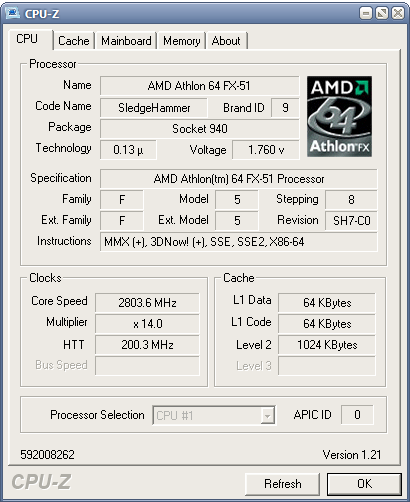Testing
The test system comprises my usual Athlon FX-51 base platform, including processor, ASUS SK8V motherboard, 1GB of memory and a review sample GeForce 6800 Ultra. In the absence of an nVentiv Mach II GT or custom phase-change unit, the LightSpeed gets the slightly rediculous task of beating Asetek's new WaterChill KT03A-L30 Antarctica cooling kit and a Cooler Master Hyper-6, a very capable air cooler. They won't stand a chance, but it lets you see the difference in performance and temperatures that phase-change buys you.Ambient room temperature was a slightly balmy 23°C for the VapoChill testing, while the air coolers enjoyed 18°C for their runs. Bear that in mind.
Remember, the LightSpeed is optimised for near 240W loads, more than any commercial processor can supply, even when overclocked. A Mach II GT, optimised for 200W loads, will offer lower processor temperatures on the whole (using current processors), but that doesn't mean the LightSpeed isn't capable of handling any current CPU load thrown at it. Far from it. A lot of emphasis is placed on absolute temperatures, and while they're important, they're not the complete focus. The LightSpeed is forward looking in terms of future heat loads from CPUs released later this year and in 2005. It still does a damn good job today though, observe.
Temperature Testing
Testing was performed both at stock CPU speed and voltage (2.2GHz, 1.5V) and at the final stable overclocked speed and voltage (2.8GHz, 1.7V).
The LightSpeed ramps up quicker than the WaterChill or Hyper-6 when load is generated, but the temperatures are way lower. At 2.2GHz the CPU temperature never rises above -12°C and the evaporator temperature as measured never rose above -40C, scaling well with the CPU temperature increase under load. Ultimate evaporator temperature at idle with an FX-51 at stock settings is -51°C.
When overclocked, the temperature dips over 0°C, but only by a couple of degrees. Load evaporator temperatures when overclocked hover around -33C.
While the LightSpeed is optimised for 240W loads, it still does a fine job with the < 200W load of a 2.8GHz Athlon FX at 1.7V.
Noise Testing
This is where the LightSpeed falls down slightly. It's a noisy bugger with the fans anywhere between 75% and 100% and they're needed up there at most heat loads, to keep the compressor cool. Asetek use a Danfoss FR8.5CL compressor with R507 gas. It's a high capacity gas but the compressor is quite small, so it has to work hard and gets quite hot at high heat loads on the evaporator.I'd estimate the fans in the LightSpeed to be a good 50dBA at full speed. The only low point of the LightSpeed experience. The XE is the model you need if you want quiet phase-change.
Overclocking Testing
I've given the game away already, but the maximum overclock for the CPU with the LightSpeed was 2.8GHz, with fans at 100%. That maxes out the SK8V's multiplier support in the BIOS, 14X being the highest choice available. A happy coincidence.
Time for some benchmarks.









